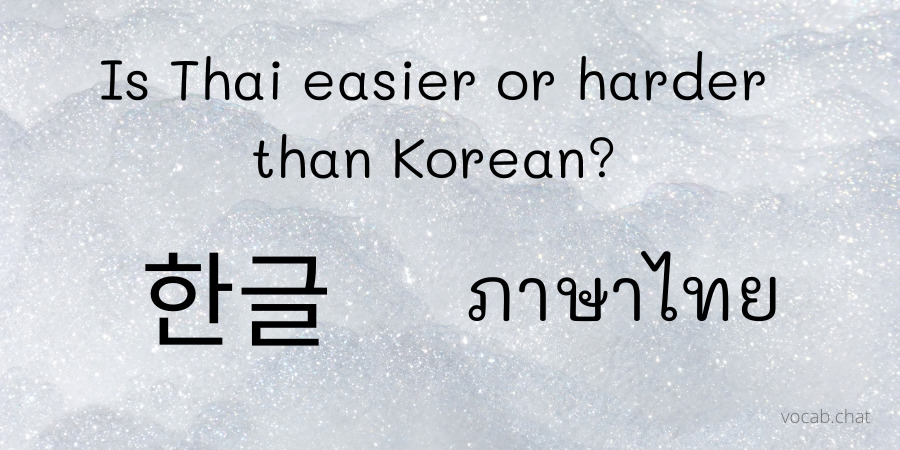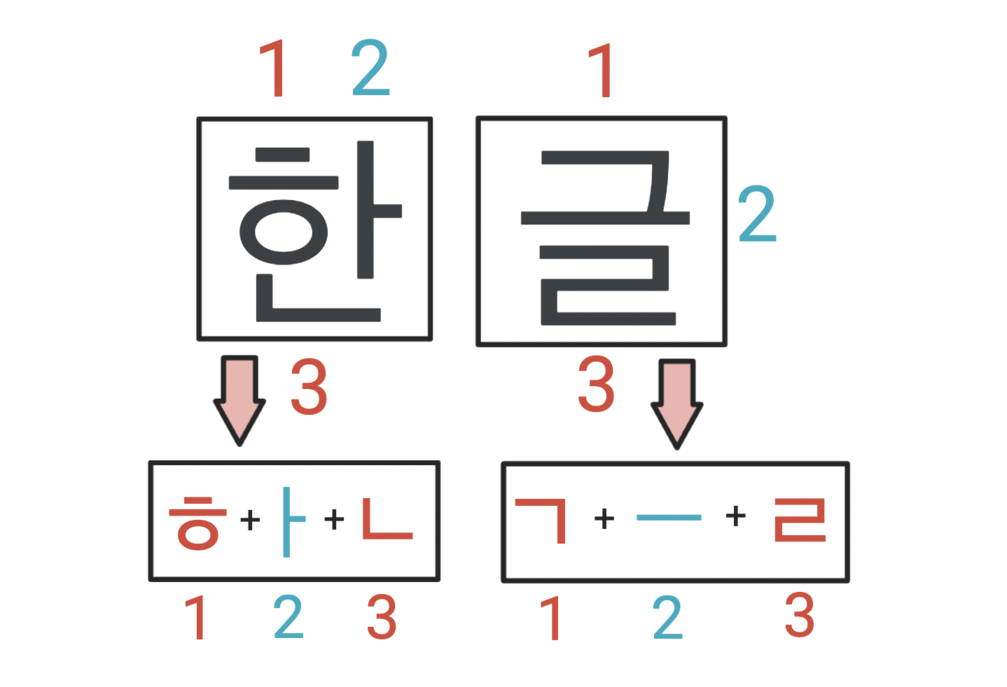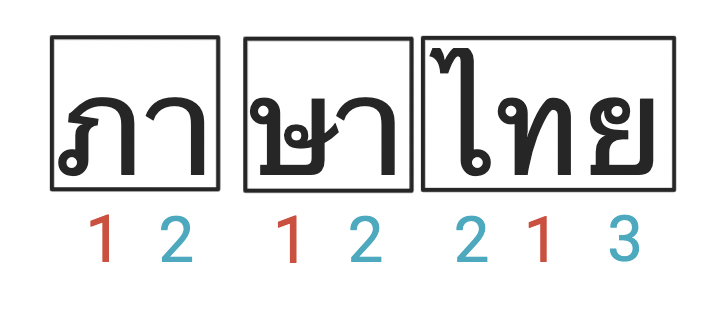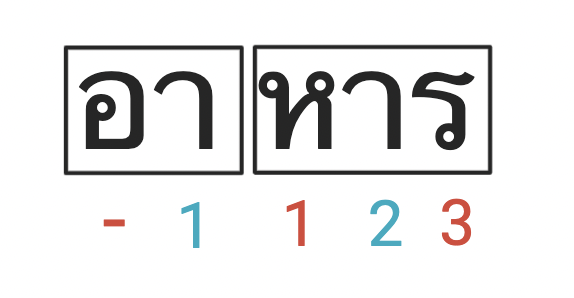
Thai vs. Korean: Which one is easier to learn?
Introduction
One hundred twenty-five million people speak Thai and Korean around the world. With both countries being popular tourist destinations and their languages being widely spoken, which would give the easiest path to mastering it?
Below, you will find a comparison of the two languages that looks at three areas - the alphabets, the grammar systems, and the pronunciation. We'll look at the differences and similarities between Thai and Korean. From this, you will know which is easier to learn.
Korean alphabet vs. Thai alphabet
The Korean alphabet and the Thai alphabet are very different from each other. They are both also quite different from the English alphabet.
The Thai alphabet has 72 characters - 44 consonants and 28 vowels. Thai is a tonal language. So different characters are going to have different ‘classes’ which determine their tone.
The Korean alphabet only has 24 letters - 10 consonants and 14 vowels. Korean is not a tonal language, so a learner must only focus on pronouncing the word. No worries about their tone changing the meaning of the word.
Korean reading systems vs. Thai reading systems
One similarity between Thai and Korean is that both are written from left to right. This is the same writing direction as we are used to in English. But not all languages are like this: Arabic, Hebrew and Persian for example are written from right to left.
Here is what the same sentence looks like when written in English, Thai and Korean:
- English: I like to play basketball.
- Thai: ผมชอบเล่นบาสเก็ตบอล
- Korean: 나는 농구하는 것을 좋아합니다
However, people write Korean horizontally and vertically. This concept will cause some confusion for new learners.
How to read Korean characters
Let’s look at an example to explain. We’ll look at the word « hangul », which is the name of the Korean alphabet. In Korean this word is written as « 한글 ».
The following examples will use this system. The red numbers will be consonants, and the blue numbers are vowels. The numbers represent the order the letters/characters are pronounced.
In each example, we will separate the words by their syllables.

Three letters make up the first character - a consonant, a vowel, then another consonant. That forms the 'han' in the word. We then go to the second character. Again, this one is a combination of three letters - a consonant, vowel, consonant. This part forms the 'gul' sound.
Koreans form the word from two characters, but it's a total of six letters.
Koreans will write the letters in Korean next to and below each other to form a word. But we will write the different characters from left to right.
How to read Thai
Thai follows a left-to-right format also but has a unique writing order.
Here is an example of the word Thai, which Thais write as « ภาษาไทย ». We pronounce this word 'pasaa thai.'

When we write the first word, which means language, it follows a simple pattern - consonant, vowel, consonant, vowel.
The second word, which means Thai, is written differently, though. It follows a vowel, consonant, vowel. There are many vowels in Thai, and they can be placed before, after, above, and below consonants.
Also, the letter in the middle of the word Thai is the initial sound - the 't' sound. So beginners must learn to put the vowels together, determine the sound, and where to say them in the word.
Let's use another example where this can get confusing. Let's look at the word «food» in Thai. Thais write it « อาหาร ». We pronounce this word 'aa-haan'.

The first character is a consonant, but it is not pronounced. Which means only the vowel is pronounced in that syllable.
In the second syllable, the last character makes the ‘r’ sound. However, when it is the final sound in a word, it makes the ’n’ sound.
Oh yeah, did we mention that the letters change sounds?
Korean character final endings vs. Thai character final endings
One similarity between Korean and Thai is that both these languages have characters that make two sounds - an initial sound and a final sound. This is an unfamiliar concept in English.
The closest example in English would be the sound 's' makes when it begins a word (s) and the sound it sometimes makes when it ends a word (z).
However, these are more common in Thai and Korean. Many characters will have an initial and final sound that differs.
Korean characters which have a different initial and final sound:- ㄱ Initial: ‘g’ Final: ‘k’
- ㄷ Initial: ‘d’ Final ’t’
- ㄹ Initial: ‘r’ Final: ‘l’
- ㅈ Initial: ‘j’ Final: ’t’
- ㅎ Initial: ‘h’ Final: ’t’
- ก Initial: ‘g’ Final: ‘k’
- จ Initial: ‘j’ Final: ’t’
- ร Initial: ‘r’ Final: ’n’
Korean grammar vs. Thai grammar
Differences in sentence structure between Thai and Korean
Thai follows a similar format to English. Sentences will follow the subject-verb-object (SVO) model. This format will make understanding Thai grammar easier.
Korean, however, follows a subject-object-verb (SOV) model. This format is going to make Korean grammar more confusing to English speakers.
Let's look at some examples, so we understand better.
English:- I want to buy fish.
- ผมอยากซื้อปลา
- Transliteration: Pom yaak sue bplaa
- Literal translation: I want buy fish.
- 나는 생선을 사고싶어요.
- Transliteration: Naneun saengseon-eul sago sip-eoyo
- Literal translation: I fish want buy.
The only difference between Thai and English is that Thai leaves out the word 'to.'
Korean is more complicated. Remembering this order will confuse beginners. Often, English speakers will apply the SVO model to Korean. By doing this, Korean listeners will be confused by the meaning.
Korean Honorifics vs. Thai honorifics
This is a concept we don't use in English. Koreans choose honorifics when dealing with different people and their status. These can be verb endings, nouns, adjectives, and pronouns.
The closest thing we have in English is when we address someone of higher status with their title. For example, when we call someone ‘doctor’ before their name when they have achieved a Ph.D., or ‘your honor’ when we address a judge.
However, Korean uses these a lot. Koreans view age and status as critical, and you change how you speak to someone based on this.
Thai, on the other hand, uses honorifics. But not as much as Korean.
Here are some examples.
Korean language honorifics
Korean Honorifics apply to nouns:
-
English meaning: house
Korean: 집(jip)
Korean honorific: 댁(daek) -
English meaning: age
Korean: 나이(nai)
Korean honorific: 연세(yeonse)
Korean Honorifics also apply to verbs:
-
English meaning: see or meet
Korean: 보다 (boda)
Korean honorific: 뵙다 (boepda) -
English meaning: give
Korean: 주다 (juda)
Korean honorific: 드리다 (deurida)
Suffixes:
The following suffixes don't have English equivalents. The closest meaning would be using Mr or Ms/Mrs when speaking to someone in most situations.
-
Korean honorific: 님 (nim)
Use: a polite way to address someone -
Korean honorific: 씨 (ssi)
Use: a way to address someone on the same level of social hierarchy -
Korean honorific: 선배님 (seonbaenim)
Use: a way to address a colleague or mentor
Korean honorifics is a really deep topic: in Korean there are 7 levels polite speech!
Thai language honorifics
Similarly to Korean, the Thai language also has a system of honorifics, but the scope of its usage is more restricted.
On a day-to-day basis, the primary honorifics that Thai language learners will use are «khun» (คุณ) and «krap/ka» (ครับ/ค่ะ).
«Khun» will be put before someone’s name to show respect. «Krap/ka» is used at the end of a sentence to make it polite. Men use «krap». Women use «ka» .
It changes when talking to or about the royal family or monks. Thai people hold these two categories of people in very high regard in Thailand.
Let’s look at the example of the word «eat».
-
Informal:
กิน (gin) -
Low formal:
ทาน (tahn) -
High formal:
รับประทาน (rab-bra-tahn) -
Talking about/to monks:
ฉัน (chan) -
Talking about/to the royal family:
เสวย (sa-woey)
This gives a small sample of the Thai honorific system. However, these are used when speaking about monks and the royal family - not daily with strangers like in Korean.
The Korean language is harder than Thai in terms of mastering levels of polite speech and honorifics.
Korean syntax vs. Thai syntax
Another difference between and Korean is the spacing between words. Thai does not use spaces between words. Korean separates words using small spaces. Here is an example:
-
English:
I will go to the market today. -
Korean:
나는 오늘 시장에 갈 것이다. -
Thai
ผมจะไปตลาดวันนี้
You can see the small spaces between the Korean characters. This will be an easy way to know where a word ends, and a new one begins.
Thai does not have this. All of the words are pushed together. To beginners, this will look like one big word.
It takes a lot of practice to understand where Thai words end and the common markers for the end. Korean's word spacing, although small, still presents a much easier path to sounding out individual words.
Korean pronunciation vs. Thai pronunciation
Korean consonants vs. Thai consonants
Korean and Thai are both going to have consonant sounds that are very familiar to beginners. This will make learning the sounds much more straightforward.
In addition, they will both contain letters and characters that make similar sounds. Here are some examples:
Korean
English sound: ‘ch’
- ㅈ
- ㅊ
English sound: 'p'
- ㅂ
- ㅍ
English sound: ‘way’
- 왜
- 외
- 웨
Thai
English sound: ‘k’
- ข
- ค
- ฆ
English sound: ‘ch’
- ฉ
- ช
- ฌ
English sound: ’t’
- ฐ
- ฒ
- ฑ
- ท
- ธ
There is only one difference between Korean and Thai in this area.
Thai has more characters with similar sounds. This is because of the class system Thai uses.
Thai has some consonants which are difficult for English-speakers to pronounce
The Thai alphabet has some characters which don't have equivalents in the English alphabet. In contrast, the consonants in the Korean alphabet are typically easier for English-speakers to pronounce.
Here are some examples:
« ง » : This sound exists in English, but it is only at the end of words. Thai uses it at the beginning and end.
Example word: งูMeaning: snake
Pronunciation: ngoo Example word: งาน
Meaning: work
Pronunciation: ngaan
« ต » : This Thai consonant is pronounced as combination of the ‘d’ and ’t’ sounds.
Example word: เต่าMeaning: turtle
Pronunciation: dtao Example word: ต้องการ
Meaning: need
Pronunciation: dtong-gaan
Thai is a tonal language whereas Korean is not
The Thai alphabet only has three classes. However, there are five tones in Thai: mid, low, high, rising, and falling. We wrote about this in another article, but this is a problematic area for beginners.
If you’re unfamiliar with tones, this is the way that saying a word in the language changes its meaning. One way can mean "dog". Say the word with a different tone, and it can mean "horse". (more about on Thai tones here)
Korean, on the other hand, is not tonal. This system will be similar to English.
The only area that can trip up learners will be homonyms. Homonyms are words that are spelled the same and sound the same but have different meanings.
However, homonyms also exist in English so that they won't be unfamiliar to most language learners.
Here are 3 examples of Korean homonyms:
-
눈 (nun)
Meaning: eye or snow -
팔 (pal)
Meaning: eight or arm -
일 (il)
Meaning: one, day, or work
Now here are 4 examples in Thai where a change in tone leads to a completely different word:
-
English sound: "maa"
-
หมา
Meaning: dog
Tone: rising -
ม้า
Meaning: horse
Tone: high -
มา
Meaning: come
Tone: mid
-
หมา
-
English sound: "yaak"
-
อยาก
Meaning: want to
Tone: low -
ยาก
Meaning: difficult
Tone: falling
-
อยาก
-
English sound: "khaao"
-
ข้าว
Meaning: rice
Tone: falling -
ขาว
Meaning: white
Tone: rising
-
ข้าว
-
English sound: "glai"
-
ไกล
Meaning: far
Tone: mid -
ใกล้
Meaning: near
Tone: falling
-
ไกล
The last example - near and far - seems like a cruel joke to play on non-native speakers. To the untrained ear, these sound identical. It will result in misunderstood directions occasionally.
There are also many interesting examples of Thai words with multiple meanings.
Conclusion
Both Thai and Korean will present challenges to beginners.
Thai will get easier as learners progress. Most of the challenges will exist in the beginning - tone, unfamiliar sounds, and reading. However, once a learner begins to acquire these, the language gets easier.
Korean, on the other hand, will become more difficult for learners. The reading system will give beginners confidence. But, once learners begin diving into the grammar system, it will be a big challenge.
The Korean grammar system is very different from English, and the use of honorifics can get very confusing.
Overall, it will come down to the time a beginner dedicates to their learning. With the correct dedication, Thai will be the easier language to master in a shorter amount of time.
